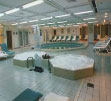
Spa Surveillance Data
Approximately 5 million public and private hot tubs, whirlpools, and spas are used in the United States . Extensive spa use combined with inadequate maintenance contribute to recreational water illnesses (RWIs) caused by pathogens such as Pseudomonas spp., Legionella spp., and Mycobacterium spp. In the United States, local environmental health inspectors periodically inspect public spas to determine their compliance with local or state health regulations. During inspections for regulatory compliance, data pertaining to spa water chemistry, filtration and recirculation, and management and operations are collected. This report summarizes spa inspection data from six sites in the United States during May 1--September 1, 2002. The findings underscore the utility of these data for public health decision-making and the need for increased training and vigilance by operators to ensure high-quality spa water for use by the public.
Data from 5,209 inspections of spas were collected from the Florida Department of Health, Bureau of Water Programs (n = 4,463); the Los Angeles County Recreational Water Program, California (n = 588); the City of St. Paul Office of License, Inspections, and Environmental Protection, Minnesota (n = 53); the Wyoming Department of Agriculture (n = 49); the Allegheny County Department of Health, Pennsylvania (n = 35); and the St. Louis County Department of Public Health, Minnesota (n = 21). The sites selected were a convenience sample of spa inspection programs with computerized data available. The data were merged into an SAS database, including date of inspection, water chemistry data (e.g., disinfectant residual and pH level), mechanical system data (e.g., operating filters and water turnover rates), and policy and management data (e.g., record keeping and operator training). A violation was noted when an inspection item was not in compliance with state or local regulations. Other inspection items (e.g., support facilities and injury control) were not addressed in this analysis.
A total of 5,378 violations were documented during the 5,209 inspections; 2,736 (52.5%) inspections occurred in spas for which the location (e.g., hotel or motel) was known . Approximately half (56.8%) of the inspections (2,958 of 5,209) had one or more violations (median: one; range: one to eight). Eleven percent (500 of 4,533) of inspections resulted in the immediate closing of spas, pending correction of the violation item(s). Water chemistry violations constituted 50.7% of all violations (2,725 of 5,378); followed by filtration and recirculation systems, 32.2% (1,732 of 5,378); and policy and management, 17.1% (921 of 5,378). Various violations for policy and management issues were documented; during inspections, 23.3% (162 of 695) of spa operators lacked required training, and 12.7% (654 of 5,153) had inadequate record keeping. For the 52.5% of inspections for which spa location could be ascertained, a range of violations occurred. For known locations collecting disinfectant residual data, the highest percentages of violations occurred in campgrounds (21.9%) and hotel/motel spas (19.6%). The percentage of inspections that documented pH level violations, which can compromise disinfectant efficiency, ranged from 14.1%--16.2% in known locations. Of those inspections that revealed violations that warranted spa closure, the highest percentages also were in campgrounds (15.1%) and hotel/motel spas (12.2%).
Reported by:
R Kebabjian, MPH, Los Angeles County, Dept of Health Svcs, Recreational Health Program, Los Angeles, California. B Bibler, Bur of Water Programs, Florida Dept of Health. R Georgesen, St. Louis County Dept of Public Health, St. Louis; P Kishel, City of St. Paul Office of License, Inspections, and Environmental Protection, St. Paul, Minnesota. D Cinpinski, MPA, Allegheny County Dept of Health, Pittsburgh, Pennsylvania. D Finkenbinder, MPA, N Bloomenrader, Wyoming Dept of Agriculture. C Otto, MPA, Div of Emergency and Environmental Health Svcs, National Center for Environmental Health; MJ Beach, PhD, J Roberts, MPH, L Mirel, MS, Div of Parasitic Diseases, National Center for Infectious Diseases; K Day, MPH, K Bauer, MS, J Yoder, MPH, Public Health Prevention Svc, CDC.
Editorial Note:
Environmental health inspections can identify weaknesses in the management and inspection of spas. In this report, the proportions of spa inspections in violation of local ordinances (56.8%) or requiring immediate closure (11.0%) are similar to those documented for public swimming pools (54.1% and 8.3%, respectively). The inspections document a gap in the training of spa operators; more than 20% of spa inspections cited operators who had not received adequate training. These data emphasize that spa operators can protect the health of users by adhering to maintenance procedures and obtaining appropriate training; regular public health enforcement of these items is necessary.
The findings also demonstrate the utility of maintaining spa inspection data in a computerized format that can be analyzed routinely and used to evaluate spa inspection programs. CDC and state and local health departments are developing guidance for systematic data collection to maximize the utility of data analysis for setting spa inspection program priorities. Consistency of data collection should allow for enhanced surveillance of spas and better evidence-based public health decision-making.
The findings in this report are subject to at least two limitations. First, the results from this analysis might not be generalizable to the entire United States because of the data's limited geographic variability (>85% of the inspections were in Florida), and these data are from the 2002 swim season. Second, data collection from the various localities revealed that database structures and variables differed and that collected data were not always entered in the database.
Poor disinfectant and pH control, high temperatures that quickly dissipate disinfectant, small water volumes, poor hygiene, high bather loads, inadequate maintenance, and opportunities for environmental contamination of the water can lead to proliferation and to pathogen contamination in the spa environment (7,8). RWIs spread through spa use are typically skin and respiratory infections in contrast to gastrointestinal illnesses commonly associated with full-body recreational activities found in swimming pools. During 1999--2000, a total of 13 reported outbreaks of infectious diseases, affecting 183 persons, were attributable to public and private spa use.
The high temperature of water in spas makes them particularly vulnerable to depletion of disinfectant, which facilitates pathogen amplification. Pathogens such as Pseudomonas spp. can multiply rapidly when the disinfectant residual falls below 0.5 mg/L or the pH rises above 8.0 (7). Pathogens also can reside in biofilm layers that form in spa pipes and surfaces, where they can be protected from disinfection (9), which necessitates routine scrubbing and maintenance to decrease biofilm formation . Because domestic acquisition of Legionella spp. appears to be travel-related (3), venues (e.g., campgrounds and hotels or motels) should pay particular attention to operator training and maintenance of their spas.
Spa users also should play a role in reducing their risk for illness . Improved public education about the health risks associated with spa use can reduce the risk for illness and increase advocacy for improved maintenance and monitoring by operators. However, successful prevention strategies must be multifaceted and address spa design, operator and inspector training, maintenance, hygiene, as well as public education. Additional information and health communication materials designed to reduce the spread of RWIs are available at http://www.cdc.gov/healthyswimming.








